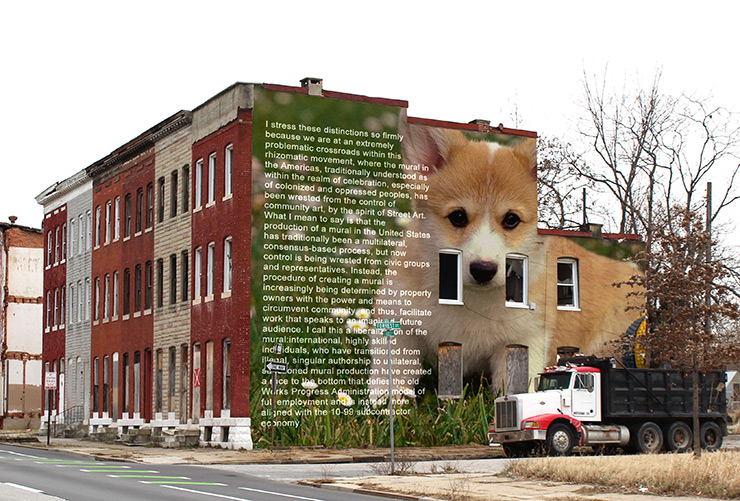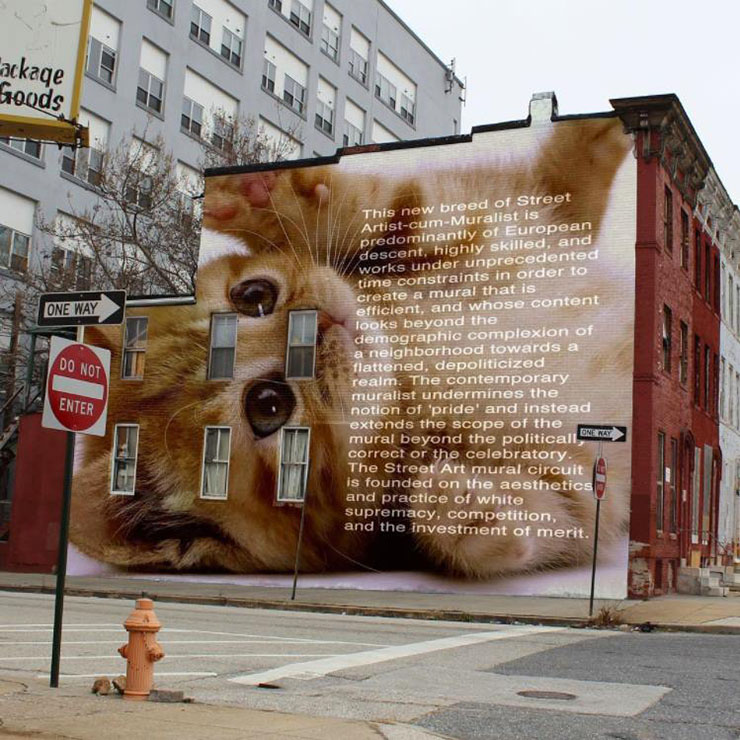![]()
He calls them “fake walls”; these mockups of murals in Baltimore that feature adorable pets. With these clever photoshopped pieces of mural fiction the Street Artist Gaia is perhaps skewering the coy shallowness of mural festivals that encourage a content-free decorative approach, rather than a substantive historically/socially/politically rooted one.

If Street Art has been hi-jacked by mural festivals from some of it’s higher minded origins, the New York born, Baltimore based Gaia has raced quickly on hot feet in the opposite direction during the last five years – preferring to immerse himself in local history, sociopolitical developments, and the implied cultural ramifications of his work.
Partially as critique to one increasingly commercial trend in Urban Art “festivals” that contorts murals as vehicles for brand and lifestyle messaging or aims only to prettify and sanitize public space, Gaia keeps assigning himself homework when he’s asked to paint in a new city, and he wishes he had more time to study.
Today we would like to share with BSA readers a recent interview he did with Shelly Clay-Robison, an adjunct faculty at York College of Pennsylvania and at the University of Baltimore who teaches peace and conflict studies and anthropology – with the hope of furthering the discussion on some of the points he raises and which we similarly have been discussing over the last few years with you.

In the interview Gaia speaks to the trivialization of the mural as meaningful expression in public space, a frequent lack of community engagement in Urban Art festivals, and his own sensitivity to what he may describe as the overwhelming whiteness and educated privilege in a scene that in many ways evolved from lower income communities of color. We’re pleased that Gaia and Ms. Clay-Robison have allowed us to share the interview with you.
From STREET ART AND CIVIC DIALOGUE: AN INTERVIEW WITH GAIA
Shelly Clay-Robison: Should we call the work you have made outside and on architecture street art, mural art, or graffiti and why would terminology matter?
Gaia: I would like to make a distinction that may seem insignificant, but is very important. Street Art, as I personally define it, is an umbrella term that seeks to explain any intervention understood as an artistic gesture, in a shared space, and must necessarily be illegal. The purview of Street Art entails anything under the rubric of contemplation or performance; tactical urbanism, painting, sculpture, etc. Murals on the other hand, are legal, sanctioned and are much more stringently understood as painting. Finally graffiti, as a tradition where the scrawling of a name becomes stylized, is a more pure action that is self-identified by its various participants as “writing” and not in fact “art.” Hence the continued relevance of the Street Art distinction.
SCR: So is it just an issue of legality then? Or are their social implications behind which type of work or medium is chosen?
Gaia: I stress these distinctions so firmly because we are at an extremely problematic crossroads within this rhizomatic movement, where the mural in the Americas, traditionally understood as within the realm of celebration, especially of colonized and oppressed peoples, has been wrested from the control of community art, by the spirit of Street Art. What I mean to say is that the production of a mural in the United States has traditionally been a multilateral, consensus-based process, but now control is being wrested from civic groups and representatives.
Instead, the procedure of creating a mural is increasingly being determined by property owners with the power and means to circumvent community, and thus, facilitate work that speaks to an imagined, future audience. I call this a liberalization of the mural: international, highly skilled individuals, who have transitioned from illegal, singular authorship to unilateral, sanctioned mural production have created a race to the bottom that defies the old Works Progress Administration model of full employment and is instead more aligned with the 10-99 subcontractor economy.
Click the link below and automatically download a PDF of the full interview here:
 BROOKLYN STREET ART LOVES YOU MORE EVERY DAY
BROOKLYN STREET ART LOVES YOU MORE EVERY DAY










